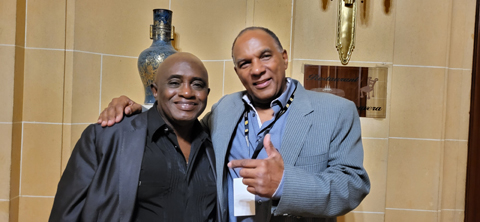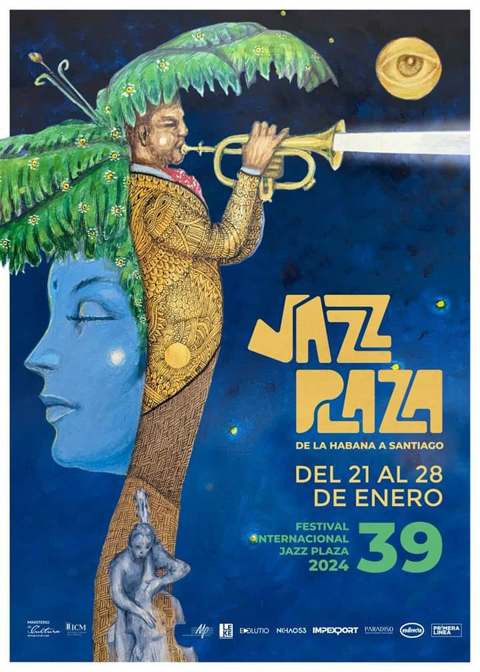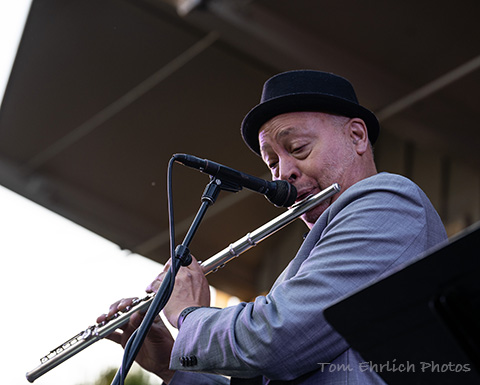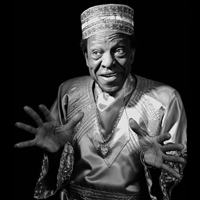New Stuff[hide]
Reportes: From The St... : Cubadisco 2...
Fotos: Tom Ehrlich
Staff: Kristina Lim
Musicos: Juan Formell
Musicos: Yordamis Megret Planes
Musicos: Yasser Morejón Pino
Musicos: José Luis "Changuito" Quintana...
Musicos: Dennis Nicles Cobas
Fotos: Eli Silva
Grupos: Ritmo Oriental : 1988 - Vol. IX - 30 a...
Musicos: Rafael Paseiro Monzón
Musicos: Jiovanni Cofiño Sánchez
Fotos: Tom Ehrlich : 2024 Monterey Jazz, P...
Resenas: Vacilón Santiaguero (Circle 9 ...
Photos of the Day [hide]
FRONT PAGE - PRIMERA PLANA
Jazz Plaza 2024: First Update / Jazz Plaza 2024: Primera Actualización
 Joaquín Betancourt y Enrique Padron
Joaquín Betancourt y Enrique Padron
ENGLISH: While the end of the COVID pandemic is a blessing overall, it also signified the end of the entensive Internet coverage of Jazz Plaza to the rest of the world (some daily highlights were shown on Cuban television). This means that you won't be able to watch the entire festival on line. However, thanks to some friends and colleagues on the ground, we will be able to present some short interviews and video clips with musicians, attendees and other figures over the next several days. We begin with producer/videographer/photographer Enrique Padron, who works with Joaquín Betancourt and attended the inaugural gala. You can hear his comments (in English) and see some short videoclips here
ESPAÑOL: Si bien el fin de la pandemia de COVID es una bendición en general, también significó el fin de la cobertura intensiva en Internet del Jazz Plaza para el resto del mundo (algunos momentos destacados diarios se transmitieron en la televisión cubana). Significa que no podrás ver toda el festival online. Sin embargo, gracias a algunos amigos y colegas sobre el terreno, podremos presentar algunas entrevistas breves y videoclips con músico, asistentes y otras figuras durante los próximos días. Comenzamos con el productor/videógrafo/fotógrafo Enrique Padron, quien trabaja con Joaquín Betancourt y asistió a la gala inaugural. Puedes escuchar sus comentarios (en inglés) y ver algunos videoclips breves aquí.
continue reading Sin Clave No Hay Na
Jazz Plaza 2024
ENGLISH: Jazz Plaza 2024 begins January 21 in Havana and Santiago de Cuba. You can find schedules, video etc. here:
ESPAÑOL: Jazz Plaza 2024 comienza el 21 de enero en La Habana y Santiago de Cuba. Puedes ver programaciones, video etc. aquí: 
continue reading Sin Clave No Hay Na
2 New Episodes of The Clave Chronicles
John Calloway on the Bay Area Scene
Lani Milstein on Conga Santiaguera
Two great new episodes of the leading Cuban music podcast:
 Tom Ehrlich's photo of John Calloway from last month's Monterey Jazz Fest
Tom Ehrlich's photo of John Calloway from last month's Monterey Jazz Fest
John Calloway on the Bay Area Scene
Lani Milstein on Conga Santiaguera
CD Reviews Are Back!
¡Reseñas de CD Regresan!

ENGLISH: After a considerable hiatus, we will be publishing CD reviews again in the future. Most of these will be recent releases made in Cuba or with musicians living in Cuba, but we are going to begin with what is believed to be the last full studio album by El Gran Fellove, recorded in 1999 in Mexico city and not released until October 7 of this year (the 100th anniversary of his birth). You can read our review of Joey Altruda Presents: El Gran Fellove in English here.
ESPAÑOL: Después de una pausa considerable, volvemos a publicar reseñas de CD en el futuro. La mayoria de ellas serán lanzamientos recientes hechos en Cuba o con músicos que viven en Cuba, pero vamos a comenzar con lo que se cree es el último álbum completo en estudio de El Gran Fellove, grabado en 1999 en la ciudad de México y lo lanzado hasta el 7 de octubre de esta año (centenario de su natalicio). Puedes leer nuestra reseña de Joey Altruda Presenta: El Gran Fellove en español aquí.
continue reading Sin Clave No Hay Na



















